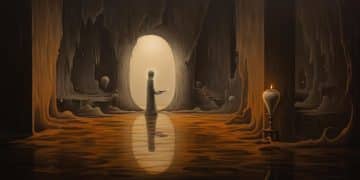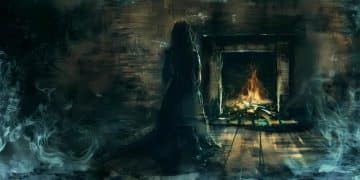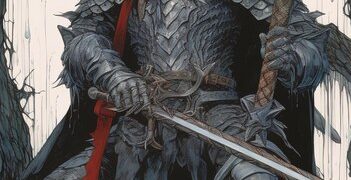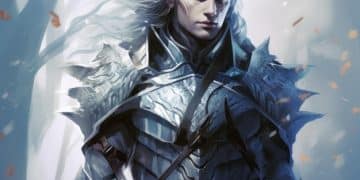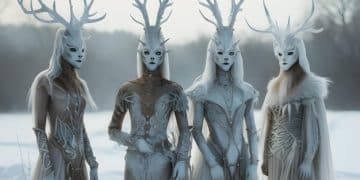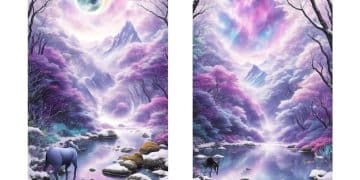The Creation of Ghouls: Dark Magic and Transformation Explained
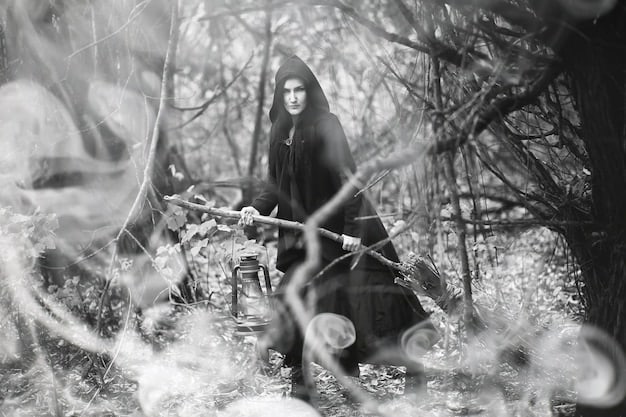
The creation of ghouls involves dark magic rituals and transformative processes, turning mortals into undead creatures driven by an insatiable hunger, often depicted in various forms of game lore and fantasy narratives.
Venture into the macabre world of game lore to uncover the secrets behind the creation of ghouls. These undead creatures, often lurking in the shadows, are brought into existence through dark magic and horrifying transformations, making them a chilling subject of fantasy narratives.
The Origins of Ghoul Lore
Ghouls have haunted humanity’s collective imagination for centuries. Understanding their origins requires delving into the historical and cultural contexts that have shaped their depiction in folklore and, subsequently, in game lore.
From ancient tales to modern video games, ghouls represent a primal fear of death and decay. This section explores the evolution of ghoul lore.
Ancient Roots and Folklore
The concept of ghouls can be traced back to ancient Arabian folklore, where they were described as desert-dwelling demons that preyed on the dead. These early ghouls were often depicted as shapeshifters capable of luring unsuspecting travelers to their doom.
Over time, these stories spread and evolved, influencing various cultures and finding their way into Western literature and, eventually, game lore.
- Arabian Ghouls: Shapeshifting demons dwelling in deserts and preying on the dead.
- European Folklore: Similar creatures found in various forms in European myths, often associated with graveyards.
- Literary Adaptations: Authors like H.P. Lovecraft popularized ghouls in modern horror.
In conclusion, the origins of ghoul lore are deeply rooted in ancient folklore and cultural anxieties about death, demons, and the unknown, influencing their depiction in modern game narratives.
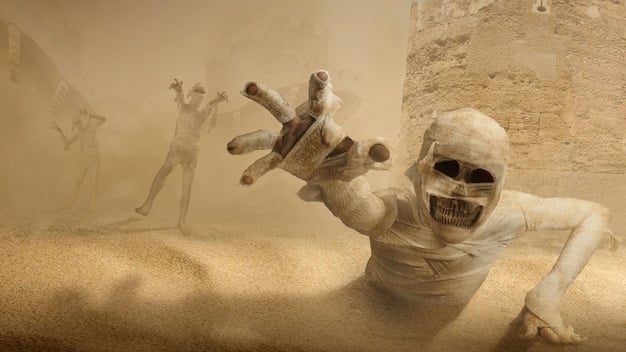
The Dark Magic Involved
The transformation of a mortal into a ghoul is rarely natural; it typically involves dark magic rituals, forbidden knowledge, and the manipulation of life forces. Understanding the specific types of magic used can shed light on the nature of these creatures.
This section explores the specific types of dark magic often associated with ghoul creation.
Necromancy and Unholy Rites
Necromancy, the practice of communicating with or raising the dead, is a common element in ghoul creation. These rituals often involve unholy rites, desecration of corpses, and the invocation of dark deities or entities.
The magic used is not merely about reanimating a body but twisting its very essence, turning it into something unnatural and driven by an insatiable hunger.
- Desecration of Corpses: Key element in necromantic rituals, often involving defilement.
- Invocation of Dark Deities: Calling upon unholy entities to grant the power of transformation.
- Manipulation of Life Forces: Twisting the essence of life into an undead state.
Ultimately, the dark magic involved in creating ghouls twists the very essence of life, reanimating bodies and enslaving them to an insatiable hunger, reflecting a deep corruption.
The Transformation Process: Step by Step
The transformation from mortal to ghoul is not instantaneous; it often involves a series of steps that gradually strip away the individual’s humanity and replace it with the grotesque characteristics associated with ghouls.
This section details the transformation process involved in becoming a ghoul.
Initial Corruption
The initial stage of transformation typically involves exposure to dark magic or tainted substances. This could be through a curse, a ritual, or even consuming the flesh of another ghoul.
The corruption begins to affect the individual’s mind and body, leading to physical and psychological changes.
- Exposure to Dark Magic: Direct contact with necromantic energies.
- Consuming Ghoul Flesh: A means of transmitting the ghoul essence.
- Curses and Rituals: Malevolent spells designed to initiate transformation.
In sum, the transformation process often starts with exposure to dark magic, curses, or the consumption of ghoul flesh, leading to a gradual corruption of the individual’s body and mind.
Physical and Psychological Changes
As the transformation progresses, the changes become more pronounced. The individual’s skin may become pale and clammy, their teeth sharpen into fangs, and their eyes take on a predatory gleam. Psychologically, they become increasingly obsessed with feeding, losing their former personality and memories.
These changes result in the grotesque creatures that haunt the shadows of game lore.
Decline of Humanity
The most tragic aspect of ghoul transformation is the loss of humanity. As the hunger intensifies, the individual’s thoughts and actions become consumed by the need to feed. Their former life, relationships, and values fade away, replaced by an insatiable craving for flesh.
- Loss of Memory: The ghoul forgets its past life and relationships.
- Diminished Morality: Ethical considerations are replaced by the primal urge to feed.
- Increased Aggression: The ghoul becomes highly territorial and aggressive.
To summarize, the physical and psychological changes in ghoul transformation result in the erosion of humanity, turning individuals into monstrous creatures driven by primal hunger.
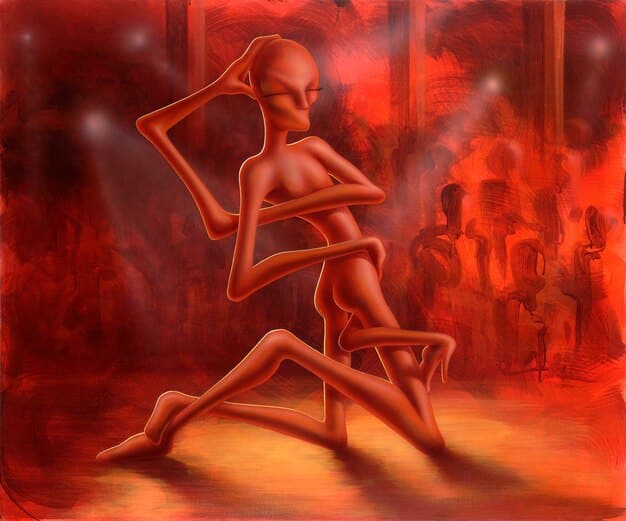
The Ghoul’s Hunger and Behavior
The driving force behind a ghoul’s existence is its insatiable hunger for flesh. This hunger dictates its behavior, driving it to seek out corpses, graves, and even living victims. Understanding this hunger is key to comprehending the nature of ghouls.
This section explores the nature of the ghoul’s hunger and its impact on their behavior.
Driven by Insatiable Hunger
Ghouls are not simply reanimated corpses; they are driven by a powerful, unnatural hunger that compels them to seek out and consume flesh. This hunger is not merely physical; it is a deep-seated, all-consuming need that dominates their existence.
It is this hunger that makes them dangerous and unpredictable.
- Necromantic Energy Drain: A constant need to replenish drained life force.
- Obsession with Flesh: A compulsion to seek out and consume flesh to sate hunger.
- Territorial Behavior: Ghouls fiercely protect their feeding grounds.
In conclusion, the ghoul’s existence is entirely dictated by an insatiable hunger for flesh, driving their behavior and making them a formidable threat in game lore.
Ghouls in Different Game Universes
Ghouls are a recurring theme in various game universes, each with its own unique interpretation of their origins, abilities, and behaviors. Exploring these different depictions can provide a broader understanding of ghoul lore.
This section examines how ghouls are portrayed in different game universes.
Variations and Interpretations
From the flesh-eating undead in fantasy RPGs to the mutated humans in post-apocalyptic settings, ghouls come in many forms. Some are mindless drones, while others retain a semblance of their former intelligence. Some are created through necromancy, while others are the result of radiation or disease.
The variations are endless, reflecting the diverse creative visions of game developers.
- Fantasy RPGs: Ghouls created through necromancy and unholy rituals.
- Post-Apocalyptic Settings: Mutated humans transformed by radiation or disease.
- Horror Games: Ghouls as grotesque creatures haunting graveyards and abandoned locations.
Overall, the portrayal of ghouls varies greatly depending on the game universe, but they all share the core elements of being undead creatures driven by an insatiable hunger, adding depth to game narratives.
| Key Point | Brief Description |
|---|---|
| 🧟 Ghoul Origins | Ancient folklore depicts ghouls as desert-dwelling demons preying on the dead. |
| 💀 Dark Magic | Necromancy and unholy rites are used to twist the essence of life into an undead state. |
| 🧬 Transformation | Exposure to dark magic or consuming ghoul flesh initiates the change, affecting body and mind. |
| 🩸 Ghoul Hunger | An insatiable need for flesh drives their behavior, making them dangerous and unpredictable. |
Frequently Asked Questions
▼
The primary motivation of a ghoul is an insatiable hunger for flesh. This hunger drives their actions and dictates their existence, making them constantly search for corpses or living victims.
▼
Dark magic, particularly necromancy, is often used to corrupt and reanimate corpses. This magic twists the essence of life, turning the body into an undead creature driven by unnatural hunger.
▼
Generally, the transformation into a ghoul involves a significant loss of memory and personality. The individual’s former life and relationships fade away, replaced by the primal urge to feed.
▼
No, ghouls can be created through various methods depending on the lore. Some are created through necromancy, while others are the result of curses, exposure to dark energy, or even consuming ghoul flesh.
▼
Ghouls are depicted in many ways across game universes. They range from mindless undead in fantasy settings to mutated humans in post-apocalyptic worlds, each with unique abilities and behaviors.
Conclusion
Exploring the dark magic and transformative processes behind the creation of ghouls offers a chilling insight into the lore that permeates many games. The grotesque nature and insatiable hunger of these undead creatures make them a compelling and terrifying element in the world of game.
